Information injection-pump assembly
ZEXEL
106873-7141
1068737141

Rating:
Service parts 106873-7141 INJECTION-PUMP ASSEMBLY:
1.
_
7.
COUPLING PLATE
8.
_
9.
_
11.
Nozzle and Holder
ME161177
12.
Open Pre:MPa(Kqf/cm2)
15.7{160}/24.5{250}
15.
NOZZLE SET
Include in #1:
106873-7141
as INJECTION-PUMP ASSEMBLY
Cross reference number
ZEXEL
106873-7141
1068737141
Zexel num
Bosch num
Firm num
Name
106873-7141
INJECTION-PUMP ASSEMBLY
Calibration Data:
Adjustment conditions
Test oil
1404 Test oil ISO4113 or {SAEJ967d}
1404 Test oil ISO4113 or {SAEJ967d}
Test oil temperature
degC
40
40
45
Nozzle and nozzle holder
105780-8250
Bosch type code
1 688 901 101
Nozzle
105780-0120
Bosch type code
1 688 901 990
Nozzle holder
105780-2190
Opening pressure
MPa
20.7
Opening pressure
kgf/cm2
211
Injection pipe
Outer diameter - inner diameter - length (mm) mm 8-3-600
Outer diameter - inner diameter - length (mm) mm 8-3-600
Overflow valve
131425-0220
Overflow valve opening pressure
kPa
157
123
191
Overflow valve opening pressure
kgf/cm2
1.6
1.25
1.95
Tester oil delivery pressure
kPa
255
255
255
Tester oil delivery pressure
kgf/cm2
2.6
2.6
2.6
Direction of rotation (viewed from drive side)
Right R
Right R
Injection timing adjustment
Direction of rotation (viewed from drive side)
Right R
Right R
Injection order
1-2-7-3-
4-5-6-8
Pre-stroke
mm
3.9
3.85
3.95
Beginning of injection position
Governor side NO.1
Governor side NO.1
Difference between angles 1
Cyl.1-2 deg. 45 44.5 45.5
Cyl.1-2 deg. 45 44.5 45.5
Difference between angles 2
Cal 1-7 deg. 90 89.5 90.5
Cal 1-7 deg. 90 89.5 90.5
Difference between angles 3
Cal 1-3 deg. 135 134.5 135.5
Cal 1-3 deg. 135 134.5 135.5
Difference between angles 4
Cal 1-4 deg. 180 179.5 180.5
Cal 1-4 deg. 180 179.5 180.5
Difference between angles 5
Cal 1-5 deg. 225 224.5 225.5
Cal 1-5 deg. 225 224.5 225.5
Difference between angles 6
Cal 1-6 deg. 270 269.5 270.5
Cal 1-6 deg. 270 269.5 270.5
Difference between angles 7
Cal 1-8 deg. 315 314.5 315.5
Cal 1-8 deg. 315 314.5 315.5
Injection quantity adjustment
Adjusting point
-
Rack position
12.8
Pump speed
r/min
650
650
650
Each cylinder's injection qty
mm3/st.
148
143.6
152.4
Basic
*
Fixing the rack
*
Standard for adjustment of the maximum variation between cylinders
*
Injection quantity adjustment_02
Adjusting point
Z
Rack position
8.5+-0.5
Pump speed
r/min
400
400
400
Each cylinder's injection qty
mm3/st.
23
19.5
26.5
Fixing the rack
*
Standard for adjustment of the maximum variation between cylinders
*
Injection quantity adjustment_03
Adjusting point
A
Rack position
R1(12.8)
Pump speed
r/min
650
650
650
Average injection quantity
mm3/st.
148
147
149
Basic
*
Fixing the lever
*
Injection quantity adjustment_04
Adjusting point
B
Rack position
R1+1.15
Pump speed
r/min
1100
1100
1100
Average injection quantity
mm3/st.
145
141
149
Fixing the lever
*
Test data Ex:
Governor adjustment
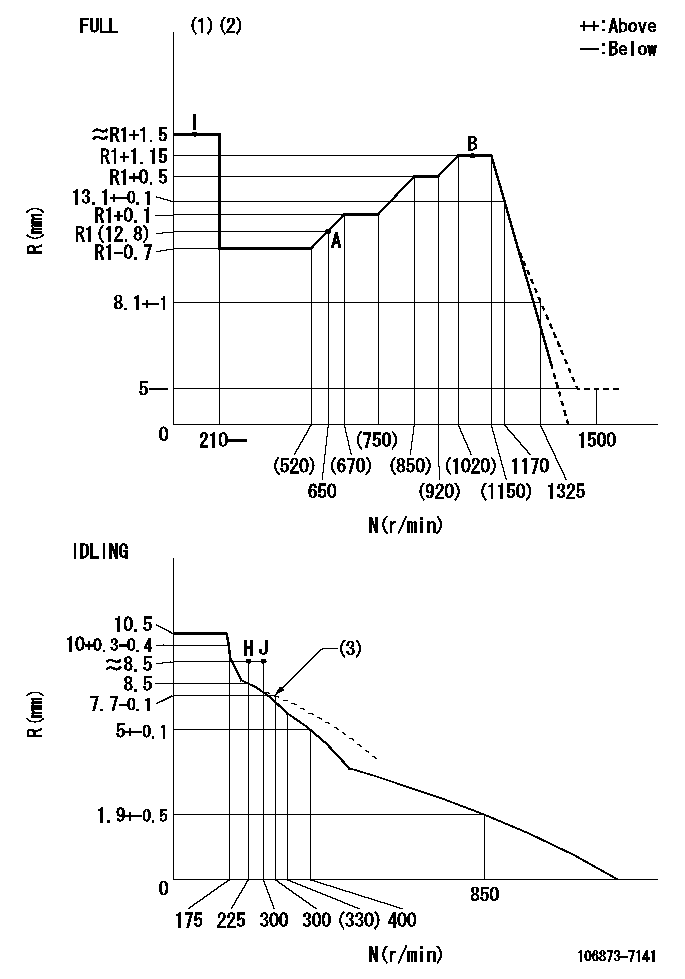
N:Pump speed
R:Rack position (mm)
(1)Torque cam stamping: T1
(2)Tolerance for racks not indicated: +-0.05mm.
(3)Damper spring setting
----------
T1=AC39
----------
----------
T1=AC39
----------
Timer adjustment
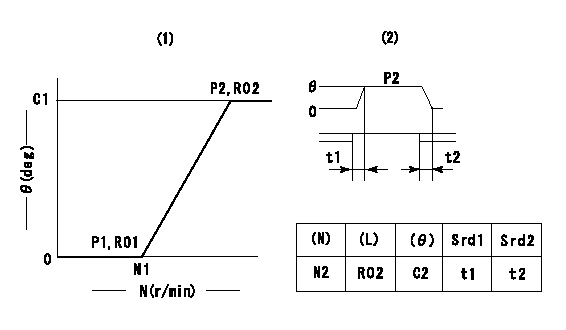
(1)Adjusting range
(2)Step response time
(N): Speed of the pump
(L): Load
(theta) Advance angle
(Srd1) Step response time 1
(Srd2) Step response time 2
1. Adjusting conditions for the variable timer
(1)Adjust the clearance between the pickup and the protrusion to L.
----------
L=1-0.2mm N2=800r/min C2=(10deg) t1=2.5--sec. t2=2.5--sec.
----------
N1=750++r/min P1=0kPa(0kgf/cm2) P2=392kPa(4kgf/cm2) C1=10+-0.3deg R01=0/4load R02=4/4load
----------
L=1-0.2mm N2=800r/min C2=(10deg) t1=2.5--sec. t2=2.5--sec.
----------
N1=750++r/min P1=0kPa(0kgf/cm2) P2=392kPa(4kgf/cm2) C1=10+-0.3deg R01=0/4load R02=4/4load
Speed control lever angle
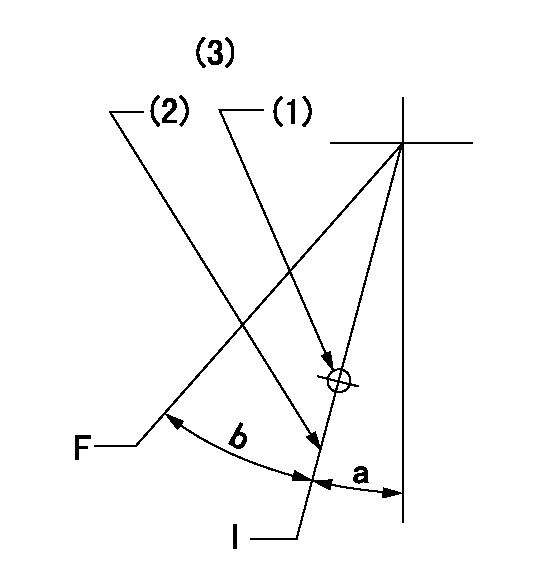
F:Full speed
I:Idle
(1)Use the hole at R = aa
(2)Stopper bolt set position 'H'
(3)Viewed from feed pump side.
----------
aa=37.5mm
----------
a=30deg+-5deg b=35deg+-3deg
----------
aa=37.5mm
----------
a=30deg+-5deg b=35deg+-3deg
Stop lever angle
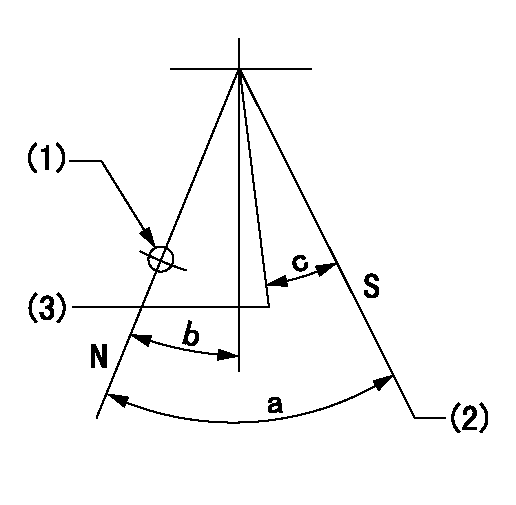
N:Pump normal
S:Stop the pump.
(1)Use the hole at R = aa
(2)Set the stopper bolt so that speed = bb and rack position = cc. (Confirm non-injection.)
(3)Normal engine position (Rack position corresponding to dd)
----------
aa=54mm bb=1100r/min cc=3.5+-0.3mm dd=18mm
----------
a=41deg+-5deg b=5.5deg+-5deg c=(31deg)
----------
aa=54mm bb=1100r/min cc=3.5+-0.3mm dd=18mm
----------
a=41deg+-5deg b=5.5deg+-5deg c=(31deg)
0000001501 MICRO SWITCH
Adjustment of the micro-switch
Adjust the bolt to obtain the following lever position when the micro-switch is ON.
(1)Speed N1
(2)Rack position Ra
----------
N1=325r/min Ra=8.5+-0.1mm
----------
----------
N1=325r/min Ra=8.5+-0.1mm
----------
0000001601 RACK SENSOR
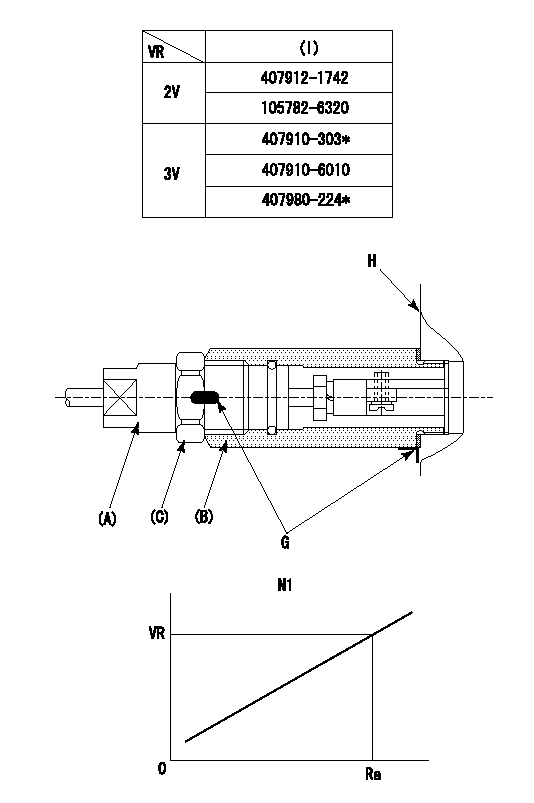
(VR) measurement voltage
(I) Part number of the control unit
(G) Apply red paint.
(H): End surface of the pump
1. Rack sensor adjustment (-0620)
(1)Fix the speed control lever at the full position
(2)Set the speed to N1 r/min.
(If the boost compensator is provided, apply boost pressure.)
(3)Adjust the bobbin (A) so that the rack sensor's output voltage is VR+-0.01.
(4)At that time, rack position must be Ra.
(5)Apply G at two places.
Connecting part between the joint (B) and the nut (F)
Connecting part between the joint (B) and the end surface of the pump (H)
----------
N1=1100r/min Ra=R1(12.8)+1.15mm
----------
----------
N1=1100r/min Ra=R1(12.8)+1.15mm
----------
Timing setting

(1)Pump vertical direction
(2)Coupling's key groove position at No 1 cylinder's beginning of injection
(3)B.T.D.C.: aa
(4)-
----------
aa=6deg
----------
a=(50deg)
----------
aa=6deg
----------
a=(50deg)
Information:
Gauges provide indications of engine performance. Be sure they are in good working order. You can determine what is the "normal" operating range by observing the gauges over a period of time.Noticeable changes in gauge readings indicate potential gauge or engine problems. This also applies to gauge readings that have changed significantly, but are still within specifications. The cause of any sudden or significant change in gauge readings should be determined and corrected. Contact your Caterpillar dealer for assistance as needed. Oil Pressure - Indicates engine oil pressure. The oil pressure should be greatest after starting a cold engine. Oil pressure should read between 240 and 480 kPa (35 and 70 psi) when: the engine is running between 600 and 2100 rpm with SAE 10W30 oil, at an operating oil temperature of 105°C (220°F). A lower pressure is normal at low idling speed.If the oil pressure gauge reading fluctuates after the load is stable:1. Remove the load.2. Reduce engine speed to low idle.3. Check and maintain the oil level.
Engine damage can result if the engine is operated with no oil pressure gauge reading. If no pressure is indicated, stop the engine.
Engine Oil Temperature - Indicates engine oil temperature. The purpose of the oil is to lubricate all moving parts inside the engine, and to cool the pistons and bearings. The oil cooler transfers the heat in the oil to the engine jacket water.If the cooling system cannot remove the necessary heat from the water, the engine oil cannot be properly cooled. Higher than normal oil temperature indicates a heat problem has occurred in the lubrication and/or cooling system, and a problem can occur with cylinder heads, liners, pistons or bearings. Maximum oil temperature is 110°C (230°F).Jacket Water Temperature - Indicates engine coolant temperature. It should normally indicate from 79 to 99°C (175 to 210°F). Higher temperatures may occur under certain conditions. Maximum allowable temperature is 105°C (220°F) with the cooling system pressurized.If the engine is operating above normal range and steam becomes apparent:1. Reduce the load and reduce the engine rpm.2. Inspect the engine for cooling system for leaks.3. Determine if the engine must be shutdown immediately or if the engine can be cooled by reducing the load. Inlet Air Temperature - Indicates inlet manifold air temperature. As the inlet air increases in temperature, the air expands, less oxygen is available in the cylinders, and less power is developed. As a result, at full speed position with a full load, the engine may be overloaded. Maximum inlet manifold air temperature is:* 110°C (230°F) for DITA engines* 163°C (325°F) for DIT engines Exhaust Stack Temperature - Indicates exhaust gas temperature. Maximum exhaust temperature is approximately 575°C (1065°F). Fuel Level - Indicates fuel level in the fuel tank. The electrically operated fuel level gauge registers only when the START/STOP (ignition) switch is ON. Fuel Pressure - Indicates fuel pressure to the injection pump. The indicator should register in the NORMAL (green) range.If the indicator moves to the OUT position or
Engine damage can result if the engine is operated with no oil pressure gauge reading. If no pressure is indicated, stop the engine.
Engine Oil Temperature - Indicates engine oil temperature. The purpose of the oil is to lubricate all moving parts inside the engine, and to cool the pistons and bearings. The oil cooler transfers the heat in the oil to the engine jacket water.If the cooling system cannot remove the necessary heat from the water, the engine oil cannot be properly cooled. Higher than normal oil temperature indicates a heat problem has occurred in the lubrication and/or cooling system, and a problem can occur with cylinder heads, liners, pistons or bearings. Maximum oil temperature is 110°C (230°F).Jacket Water Temperature - Indicates engine coolant temperature. It should normally indicate from 79 to 99°C (175 to 210°F). Higher temperatures may occur under certain conditions. Maximum allowable temperature is 105°C (220°F) with the cooling system pressurized.If the engine is operating above normal range and steam becomes apparent:1. Reduce the load and reduce the engine rpm.2. Inspect the engine for cooling system for leaks.3. Determine if the engine must be shutdown immediately or if the engine can be cooled by reducing the load. Inlet Air Temperature - Indicates inlet manifold air temperature. As the inlet air increases in temperature, the air expands, less oxygen is available in the cylinders, and less power is developed. As a result, at full speed position with a full load, the engine may be overloaded. Maximum inlet manifold air temperature is:* 110°C (230°F) for DITA engines* 163°C (325°F) for DIT engines Exhaust Stack Temperature - Indicates exhaust gas temperature. Maximum exhaust temperature is approximately 575°C (1065°F). Fuel Level - Indicates fuel level in the fuel tank. The electrically operated fuel level gauge registers only when the START/STOP (ignition) switch is ON. Fuel Pressure - Indicates fuel pressure to the injection pump. The indicator should register in the NORMAL (green) range.If the indicator moves to the OUT position or
Have questions with 106873-7141?
Group cross 106873-7141 ZEXEL
Mitsubishi
Mitsubishi
Mitsubishi
106873-7141
INJECTION-PUMP ASSEMBLY